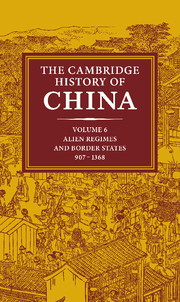Book contents
- Frontmatter
- Introduction
- 1 The Liao
- 2 The Hsi Hsia
- 3 The Chin dynasty
- 4 The rise of the Mongolian empire and Mongolian rule in north China
- 5 The reign of Khubilai khan
- 6 Mid-Yüan politics
- 7 Shun-ti and the end of Yüan rule in China
- 8 The Yüan government and society
- 9 Chinese society under Mongol rule, 1215–1368
- Bibliographical essays
- Bibliography
- Glossary-Index
- MAP 7. The Liao empire, ca. 1045
- MAP 12. The Hsi Hsia state, IIII
- Map 17. The Chin empire
- MAP 32. The Yüan empire">
Bibliographical essays
Published online by Cambridge University Press: 28 March 2008
- Frontmatter
- Introduction
- 1 The Liao
- 2 The Hsi Hsia
- 3 The Chin dynasty
- 4 The rise of the Mongolian empire and Mongolian rule in north China
- 5 The reign of Khubilai khan
- 6 Mid-Yüan politics
- 7 Shun-ti and the end of Yüan rule in China
- 8 The Yüan government and society
- 9 Chinese society under Mongol rule, 1215–1368
- Bibliographical essays
- Bibliography
- Glossary-Index
- MAP 7. The Liao empire, ca. 1045
- MAP 12. The Hsi Hsia state, IIII
- Map 17. The Chin empire
- MAP 32. The Yüan empire">
Summary
THE LIAO
Traditional sources
The Liao is a particularly poorly documented period. Its government, like all Chinese bureaucracies, produced a mass of paperwork, written in both Chinese and Khitan. But little of this documentation survived the fall of the dynasty, and nothing remains today.
The peculiar nature of the Liao government was an important factor in the poverty of the historical record. Although it supported court diarists and a historiographical office, its historians never achieved the smooth routines and professional competence of their successors under the Chin, let alone of their Sung contemporaries. One reason for this was the fact that even until the end of the dynasty the Liao never had a static capital, palace, court, and government on the Chinese model. The Khitan court remained peripatetic, the emperors never abandoning their annual tours around their empire and their annual visits to the four seasonal camps (na-po). This style of government was not conducive to keeping orderly state archives. Nor was the personal arbitrary style of government at every level, and the Liao's fragmented administrative structure, divided into northern (tribal) and southern (Chinese) bureaus, the former keeping some of their records in Khitan and the latter exclusively employing Chinese.
- Type
- Chapter
- Information
- The Cambridge History of China , pp. 665 - 726Publisher: Cambridge University PressPrint publication year: 1994

